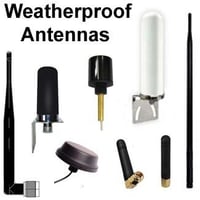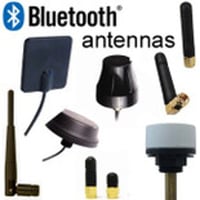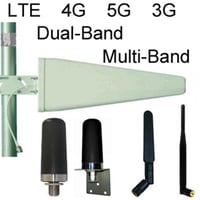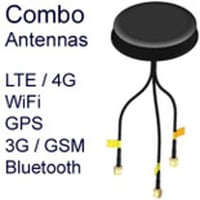Wall Mounts
Wall Mounts for Antennas
Antennas, in their varied shapes and sizes, play a crucial role in the world of communication. But to get the best reception or transmission, positioning your antenna correctly is of paramount importance. This is where wall mounts come into the picture. Let's delve into the world of wall mounts for antennas to understand their types, key features, applications, and materials composition.
Types of Wall Mounts for Antennas
-
Standard Wall Mounts: These are the most commonly used mounts and are designed to fit most antennas. They usually consist of a simple bracket system.
-
Adjustable Wall Mounts: These allow you to change the angle and position of the antenna for optimal signal reception. It's especially beneficial in areas where signals fluctuate.
-
Pole Mounts: Attached to the wall, these mounts have an extended pole that provides additional height, which can help in avoiding obstacles that might interfere with the signal.
-
Corner Mounts: Designed specifically to fit corners, they are ideal for installations where space is limited or where a centered wall mounting is not feasible.
Key Features
-
Durability: A good wall mount should withstand extreme weather conditions, especially if it's installed outside.
-
Flexibility: Adjustable mounts should offer flexibility in terms of positioning. This helps in fine-tuning antenna angles for better reception.
-
Load Capacity: Depending on the weight and size of the antenna, the wall mount should be able to support it without any issues.
-
Ease of Installation: Nobody likes a complicated setup. The design should be such that even someone with basic DIY skills can install it.
-
Rust and Corrosion Resistance: As these mounts are often exposed to external environments, resistance to rust and corrosion is essential.
Applications
-
Home Television Antennas: For those who use aerials to catch TV signals, wall mounts help position these antennas effectively.
-
Satellite Dishes: While larger dishes might need sturdier setups, wall mounts are still employed for smaller satellite dishes.
-
Ham Radio: Amateur radio enthusiasts often use wall mounts to set up their equipment for optimal transmission.
-
Wi-Fi Antennas: Increasingly, as Wi-Fi becomes more ubiquitous, wall mounts are being used to position Wi-Fi antennas for better range and connectivity.
-
Security Systems: Surveillance cameras and other security devices often use antenna systems that are wall-mounted for better coverage.
Materials Composition
Wall mounts for antennas are primarily made using:
-
Galvanized Steel: Known for its strength and resistance to rust, it's a common choice for outdoor mounts.
-
Stainless Steel: This offers even better corrosion resistance than galvanized steel, especially in coastal areas.
-
Aluminum: Lightweight and resistant to corrosion, aluminum is another popular choice, especially for smaller antenna systems.
-
Plastic or Polymer Brackets: Used in conjunction with metal for certain components, they provide flexibility and weather resistance.
To conclude, when it comes to ensuring optimal signal strength and clarity, the right wall mount for your antenna is indispensable. Whether it's for TV, radio, Wi-Fi, or security systems, choosing the right type with the right features made of suitable material can make a world of difference. So, next time you think of antennas, remember that what's behind (or beneath) them – the wall mount – is just as crucial.
Wall Mounts for Antennas: An Insightful Guide
Antennas, in their varied shapes and sizes, play a crucial role in the world of communication. But to get the best reception or transmission, positioning your antenna correctly is of paramount importance. This is where wall mounts come into the picture. Let's delve into the world of wall mounts for antennas to understand their types, key features, applications, and materials composition.
Types of Wall Mounts for Antennas
-
Standard Wall Mounts: These are the most commonly used mounts and are designed to fit most antennas. They usually consist of a simple bracket system.
-
Adjustable Wall Mounts: These allow you to change the angle and position of the antenna for optimal signal reception. It's especially beneficial in areas where signals fluctuate.
-
Pole Mounts: Attached to the wall, these mounts have an extended pole that provides additional height, which can help in avoiding obstacles that might interfere with the signal.
-
Corner Mounts: Designed specifically to fit corners, they are ideal for installations where space is limited or where a centered wall mounting is not feasible.
Key Features
-
Durability: A good wall mount should withstand extreme weather conditions, especially if it's installed outside.
-
Flexibility: Adjustable mounts should offer flexibility in terms of positioning. This helps in fine-tuning antenna angles for better reception.
-
Load Capacity: Depending on the weight and size of the antenna, the wall mount should be able to support it without any issues.
-
Ease of Installation: Nobody likes a complicated setup. The design should be such that even someone with basic DIY skills can install it.
-
Rust and Corrosion Resistance: As these mounts are often exposed to external environments, resistance to rust and corrosion is essential.
Applications
-
Home Television Antennas: For those who use aerials to catch TV signals, wall mounts help position these antennas effectively.
-
Satellite Dishes: While larger dishes might need sturdier setups, wall mounts are still employed for smaller satellite dishes.
-
Ham Radio: Amateur radio enthusiasts often use wall mounts to set up their equipment for optimal transmission.
-
Wi-Fi Antennas: Increasingly, as Wi-Fi becomes more ubiquitous, wall mounts are being used to position Wi-Fi antennas for better range and connectivity.
-
Security Systems: Surveillance cameras and other security devices often use antenna systems that are wall-mounted for better coverage.
Materials Composition
Wall mounts for antennas are primarily made using:
-
Galvanized Steel: Known for its strength and resistance to rust, it's a common choice for outdoor mounts.
-
Stainless Steel: This offers even better corrosion resistance than galvanized steel, especially in coastal areas.
-
Aluminum: Lightweight and resistant to corrosion, aluminum is another popular choice, especially for smaller antenna systems.
-
Plastic or Polymer Brackets: Used in conjunction with metal for certain components, they provide flexibility and weather resistance.
To conclude, when it comes to ensuring optimal signal strength and clarity, the right wall mount for your antenna is indispensable. Whether it's for TV, radio, Wi-Fi, or security systems, choosing the right type with the right features made of suitable material can make a world of difference. So, next time you think of antennas, remember that what's behind (or beneath) them – the wall mount – is just as crucial.
Wall Mounts for Antennas: An Insightful Guide
Antennas, in their varied shapes and sizes, play a crucial role in the world of communication. But to get the best reception or transmission, positioning your antenna correctly is of paramount importance. This is where wall mounts come into the picture. Let's delve into the world of wall mounts for antennas to understand their types, key features, applications, and materials composition.
Types of Wall Mounts for Antennas
-
Standard Wall Mounts: These are the most commonly used mounts and are designed to fit most antennas. They usually consist of a simple bracket system.
-
Adjustable Wall Mounts: These allow you to change the angle and position of the antenna for optimal signal reception. It's especially beneficial in areas where signals fluctuate.
-
Pole Mounts: Attached to the wall, these mounts have an extended pole that provides additional height, which can help in avoiding obstacles that might interfere with the signal.
-
Corner Mounts: Designed specifically to fit corners, they are ideal for installations where space is limited or where a centered wall mounting is not feasible.
Key Features
-
Durability: A good wall mount should withstand extreme weather conditions, especially if it's installed outside.
-
Flexibility: Adjustable mounts should offer flexibility in terms of positioning. This helps in fine-tuning antenna angles for better reception.
-
Load Capacity: Depending on the weight and size of the antenna, the wall mount should be able to support it without any issues.
-
Ease of Installation: Nobody likes a complicated setup. The design should be such that even someone with basic DIY skills can install it.
-
Rust and Corrosion Resistance: As these mounts are often exposed to external environments, resistance to rust and corrosion is essential.
Applications
-
Home Television Antennas: For those who use aerials to catch TV signals, wall mounts help position these antennas effectively.
-
Satellite Dishes: While larger dishes might need sturdier setups, wall mounts are still employed for smaller satellite dishes.
-
Ham Radio: Amateur radio enthusiasts often use wall mounts to set up their equipment for optimal transmission.
-
Wi-Fi Antennas: Increasingly, as Wi-Fi becomes more ubiquitous, wall mounts are being used to position Wi-Fi antennas for better range and connectivity.
-
Security Systems: Surveillance cameras and other security devices often use antenna systems that are wall-mounted for better coverage.
Materials Composition
Wall mounts for antennas are primarily made using:
-
Galvanized Steel: Known for its strength and resistance to rust, it's a common choice for outdoor mounts.
-
Stainless Steel: This offers even better corrosion resistance than galvanized steel, especially in coastal areas.
-
Aluminum: Lightweight and resistant to corrosion, aluminum is another popular choice, especially for smaller antenna systems.
-
Plastic or Polymer Brackets: Used in conjunction with metal for certain components, they provide flexibility and weather resistance.
To conclude, when it comes to ensuring optimal signal strength and clarity, the right wall mount for your antenna is indispensable. Whether it's for TV, radio, Wi-Fi, or security systems, choosing the right type with the right features made of suitable material can make a world of difference. So, next time you think of antennas, remember that what's behind (or beneath) them – the wall mount – is just as crucial.
Wall Mounts for Antennas: An Insightful Guide
Antennas, in their varied shapes and sizes, play a crucial role in the world of communication. But to get the best reception or transmission, positioning your antenna correctly is of paramount importance. This is where wall mounts come into the picture. Let's delve into the world of wall mounts for antennas to understand their types, key features, applications, and materials composition.
Types of Wall Mounts for Antennas
-
Standard Wall Mounts: These are the most commonly used mounts and are designed to fit most antennas. They usually consist of a simple bracket system.
-
Adjustable Wall Mounts: These allow you to change the angle and position of the antenna for optimal signal reception. It's especially beneficial in areas where signals fluctuate.
-
Pole Mounts: Attached to the wall, these mounts have an extended pole that provides additional height, which can help in avoiding obstacles that might interfere with the signal.
-
Corner Mounts: Designed specifically to fit corners, they are ideal for installations where space is limited or where a centered wall mounting is not feasible.
Key Features
-
Durability: A good wall mount should withstand extreme weather conditions, especially if it's installed outside.
-
Flexibility: Adjustable mounts should offer flexibility in terms of positioning. This helps in fine-tuning antenna angles for better reception.
-
Load Capacity: Depending on the weight and size of the antenna, the wall mount should be able to support it without any issues.
-
Ease of Installation: Nobody likes a complicated setup. The design should be such that even someone with basic DIY skills can install it.
-
Rust and Corrosion Resistance: As these mounts are often exposed to external environments, resistance to rust and corrosion is essential.
Applications
-
Home Television Antennas: For those who use aerials to catch TV signals, wall mounts help position these antennas effectively.
-
Satellite Dishes: While larger dishes might need sturdier setups, wall mounts are still employed for smaller satellite dishes.
-
Ham Radio: Amateur radio enthusiasts often use wall mounts to set up their equipment for optimal transmission.
-
Wi-Fi Antennas: Increasingly, as Wi-Fi becomes more ubiquitous, wall mounts are being used to position Wi-Fi antennas for better range and connectivity.
-
Security Systems: Surveillance cameras and other security devices often use antenna systems that are wall-mounted for better coverage.
Materials Composition
Wall mounts for antennas are primarily made using:
-
Galvanized Steel: Known for its strength and resistance to rust, it's a common choice for outdoor mounts.
-
Stainless Steel: This offers even better corrosion resistance than galvanized steel, especially in coastal areas.
-
Aluminum: Lightweight and resistant to corrosion, aluminum is another popular choice, especially for smaller antenna systems.
-
Plastic or Polymer Brackets: Used in conjunction with metal for certain components, they provide flexibility and weather resistance.
To conclude, when it comes to ensuring optimal signal strength and clarity, the right wall mount for your antenna is indispensable. Whether it's for TV, radio, Wi-Fi, or security systems, choosing the right type with the right features made of suitable material can make a world of difference. So, next time you think of antennas, remember that what's behind (or beneath) them – the wall mount – is just as crucial.
Wall Mounts for Antennas: An Insightful Guide
Antennas, in their varied shapes and sizes, play a crucial role in the world of communication. But to get the best reception or transmission, positioning your antenna correctly is of paramount importance. This is where wall mounts come into the picture. Let's delve into the world of wall mounts for antennas to understand their types, key features, applications, and materials composition.
Types of Wall Mounts for Antennas
-
Standard Wall Mounts: These are the most commonly used mounts and are designed to fit most antennas. They usually consist of a simple bracket system.
-
Adjustable Wall Mounts: These allow you to change the angle and position of the antenna for optimal signal reception. It's especially beneficial in areas where signals fluctuate.
-
Pole Mounts: Attached to the wall, these mounts have an extended pole that provides additional height, which can help in avoiding obstacles that might interfere with the signal.
-
Corner Mounts: Designed specifically to fit corners, they are ideal for installations where space is limited or where a centered wall mounting is not feasible.
Key Features
-
Durability: A good wall mount should withstand extreme weather conditions, especially if it's installed outside.
-
Flexibility: Adjustable mounts should offer flexibility in terms of positioning. This helps in fine-tuning antenna angles for better reception.
-
Load Capacity: Depending on the weight and size of the antenna, the wall mount should be able to support it without any issues.
-
Ease of Installation: Nobody likes a complicated setup. The design should be such that even someone with basic DIY skills can install it.
-
Rust and Corrosion Resistance: As these mounts are often exposed to external environments, resistance to rust and corrosion is essential.
Applications
-
Home Television Antennas: For those who use aerials to catch TV signals, wall mounts help position these antennas effectively.
-
Satellite Dishes: While larger dishes might need sturdier setups, wall mounts are still employed for smaller satellite dishes.
-
Ham Radio: Amateur radio enthusiasts often use wall mounts to set up their equipment for optimal transmission.
-
Wi-Fi Antennas: Increasingly, as Wi-Fi becomes more ubiquitous, wall mounts are being used to position Wi-Fi antennas for better range and connectivity.
-
Security Systems: Surveillance cameras and other security devices often use antenna systems that are wall-mounted for better coverage.
Materials Composition
Wall mounts for antennas are primarily made using:
-
Galvanized Steel: Known for its strength and resistance to rust, it's a common choice for outdoor mounts.
-
Stainless Steel: This offers even better corrosion resistance than galvanized steel, especially in coastal areas.
-
Aluminum: Lightweight and resistant to corrosion, aluminum is another popular choice, especially for smaller antenna systems.
-
Plastic or Polymer Brackets: Used in conjunction with metal for certain components, they provide flexibility and weather resistance.
To conclude, when it comes to ensuring optimal signal strength and clarity, the right wall mount for your antenna is indispensable. Whether it's for TV, radio, Wi-Fi, or security systems, choosing the right type with the right features made of suitable material can make a world of difference. So, next time you think of antennas, remember that what's behind (or beneath) them – the wall mount – is just as crucial.
## Wall Mounts for Antennas: An Insightful Guide
Antennas, in their varied shapes and sizes, play a crucial role in the world of communication. But to get the best reception or transmission, positioning your antenna correctly is of paramount importance. This is where wall mounts come into the picture. Let's delve into the world of wall mounts for antennas to understand their types, key features, applications, and materials composition.
### Types of Wall Mounts for Antennas
1. **Standard Wall Mounts**: These are the most commonly used mounts and are designed to fit most antennas. They usually consist of a simple bracket system.
2. **Adjustable Wall Mounts**: These allow you to change the angle and position of the antenna for optimal signal reception. It's especially beneficial in areas where signals fluctuate.
3. **Pole Mounts**: Attached to the wall, these mounts have an extended pole that provides additional height, which can help in avoiding obstacles that might interfere with the signal.
4. **Corner Mounts**: Designed specifically to fit corners, they are ideal for installations where space is limited or where a centered wall mounting is not feasible.
### Key Features
1. **Durability**: A good wall mount should withstand extreme weather conditions, especially if it's installed outside.
2. **Flexibility**: Adjustable mounts should offer flexibility in terms of positioning. This helps in fine-tuning antenna angles for better reception.
3. **Load Capacity**: Depending on the weight and size of the antenna, the wall mount should be able to support it without any issues.
4. **Ease of Installation**: Nobody likes a complicated setup. The design should be such that even someone with basic DIY skills can install it.
5. **Rust and Corrosion Resistance**: As these mounts are often exposed to external environments, resistance to rust and corrosion is essential.
### Applications
1. **Home Television Antennas**: For those who use aerials to catch TV signals, wall mounts help position these antennas effectively.
2. **Satellite Dishes**: While larger dishes might need sturdier setups, wall mounts are still employed for smaller satellite dishes.
3. **Ham Radio**: Amateur radio enthusiasts often use wall mounts to set up their equipment for optimal transmission.
4. **Wi-Fi Antennas**: Increasingly, as Wi-Fi becomes more ubiquitous, wall mounts are being used to position Wi-Fi antennas for better range and connectivity.
5. **Security Systems**: Surveillance cameras and other security devices often use antenna systems that are wall-mounted for better coverage.
### Materials Composition
Wall mounts for antennas are primarily made using:
1. **Galvanized Steel**: Known for its strength and resistance to rust, it's a common choice for outdoor mounts.
2. **Stainless Steel**: This offers even better corrosion resistance than galvanized steel, especially in coastal areas.
3. **Aluminum**: Lightweight and resistant to corrosion, aluminum is another popular choice, especially for smaller antenna systems.
4. **Plastic or Polymer Brackets**: Used in conjunction with metal for certain components, they provide flexibility and weather resistance.
To conclude, when it comes to ensuring optimal signal strength and clarity, the right wall mount for your antenna is indispensable. Whether it's for TV, radio, Wi-Fi, or security systems, choosing the right type with the right features made of suitable material can make a world of difference. So, next time you think of antennas, remember that what's behind (or beneath) them – the wall mount – is just as crucial.







